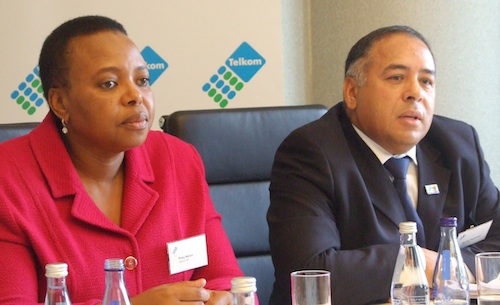
Telecommunications operator Telkom, which will launch SA’s fourth mobile operator next year, will lobby the Independent Communications Authority of SA (Icasa) for an asymmetric interconnection fee regime that is skewed in its favour.
Telkom group CEO Reuben September, pictured above with Telkom SA MD Pinky Moholi, says it is fair for new entrants to expect asymmetry to give them a leg-up to compete with the incumbent players. Mobile interconnection rates are the fees cellphone operators charge each other and other operators to carry calls on their networks.
It’s not the first time an SA operator has called for an asymmetric regime. Cell C CEO Lars Reichelt is lobbying hard for his company to benefit, too.
“It must be recognised that we don’t have the scale that the other mobile operators have so therefore there should be a case for asymmetry in favour of Telkom,” September says. “How will we proceed with that process? We will have an engagement with Icasa and respect those processes. But it is appropriate for Telkom to have asymmetry.”
Telkom on Tuesday said it had committed to spend as much as R6bn in the next five years building a national mobile network based on GSM (2G) and wideband CDMA (3G) technologies.
The group is reluctant to provide details about its plans, citing competitive reasons, but it has confirmed that it has contracted China’s Huawei to build the network for it.
The 3G component of the network will offer high-speed packet access — 7,2Mbit/s downlink and 1,8Mbit/s uplink at launch. The network equipment is ready to support the next-generation Long-Term Evolution, or LTE, wireless standard through a software upgrade.
Telkom is in discussions with both MTN and Vodacom with a view to signing a roaming agreement to cater for people who wander outside the company’s coverage areas. Coverage will be limited initially to urban areas, including townships. — Duncan McLeod, TechCentral
- See also: Telkom outlines mobile spending plans




